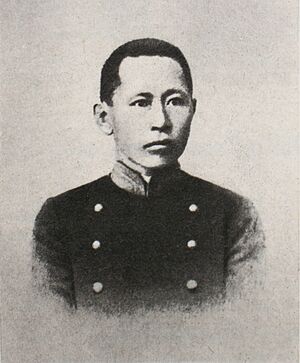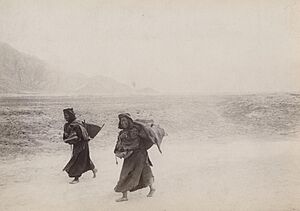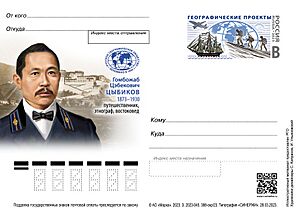Gombojab Tsybikov facts for kids
Quick facts for kids
Gombojab Tsybikov
|
|
|---|---|

Gombojab Tsybikov in a 1900 portrait
|
|
| Born |
Gombojab Tsebekovich Tsybikov
20 April 1873 Urdo-Aga, Transbaikal Oblast, Russian Empire
|
| Died | 20 September 1930 (aged 57) Aginskoye, Buryat-Mongol ASSR, Soviet Union
|
| Nationality | Buryat |
| Occupation | Russian explorer of Tibet, social anthropologist, photographer, educator, statesman |
Gombojab Tsybikov (Russian: Гомбожаб Цэбекович Цыбиков; Buryat: Цэбэгэй Гомбожаб, Mongolian: Цэвэгийн Гомбожав; 20 April 1873 – 20 September 1930) was a brave Russian explorer. He traveled to Tibet between 1899 and 1902. Tsybikov was also a social scientist, photographer, teacher, and an important leader. He worked in Siberia and Mongolia after 1917.
Tsybikov is famous for being the first person to take photos of Tibet. This includes pictures of its capital city, Lhasa. His travel stories were published in a book. This book had many details from Tibetan sources. It also shared his own experiences about Tibet. This made his book a very important source of information.
Contents
Who Was Gombojab Tsybikov?
Gombojab's Early Life and Education
Gombojab Tsybikov was born on April 20, 1873. His family were Buryats from the Transbaikal region. They followed Tibetan Buddhism. His father, Tsebek Montuyev, studied Mongolian and Tibetan languages. He wanted Gombojab to study at a Buddhist monastery at first.
But later, his father sent him to a school in Aga to learn Russian. Gombojab then went to a high school in Chita. He finished with excellent grades. This helped him get a special scholarship. He used it to go to university. At that time, he wanted to become a medical doctor.
In the mid-1890s, Gombojab met Dr. Peter Badmayev at Tomsk University. Dr. Badmayev suggested that Tsybikov should study Asian affairs. He offered to support Tsybikov if he went to St Petersburg University. To prepare, Tsybikov spent time in Urga. There, he learned Chinese, Mongolian, and Manchu languages.
In 1895, he started studying at St. Petersburg University. He had a grant from P. Badmayev. However, he lost Badmayev's support. This was because Tsybikov refused to change from Buddhism to Christianity. But he still managed to finish his studies. He got funds from his hometown and graduated with top honors in 1899.
His Journey to Tibet
Soon after graduating, the Russian Academy of Sciences sent Gombojab Tsybikov to explore Tibet. He traveled from Russia through Mongolia to Lhasa. He joined a group of Buryat and Kalmyk pilgrims. Tsybikov used clever ways to hide his equipment and notes. This was because foreigners were not usually allowed in Tibet.
His journey started in 1899 and ended in 1902. He spent 888 days in Tibet, mostly in and around Lhasa, from 1900 to 1901. While there, he secretly took about 200 pictures.
These photos, along with others taken by another Russian explorer named Kalmyk Ovshe Norzunov, became very famous. Tsybikov arrived in Lhasa in August 1900. Norzunov arrived later that year. Their pictures were featured in the National Geographic Magazine in January 1905. This was a big moment for the magazine. It helped make National Geographic popular for its amazing photos.
Tsybikov also had a formal meeting with the Dalai Lama. Later, when the Dalai Lama left Tibet in 1904, he stayed in Urga, Mongolia. Gombojab Tsybikov helped by acting as an interpreter during the Dalai Lama's talks with Russian officials. The Dalai Lama was very happy to receive a collection of Tsybikov's and Norzunov's photos of Tibet. These were published by the Russian Geographic Society.
However, after Russia lost the Russo-Japanese war, Russia stopped being as involved in Tibetan affairs. Between his travels and the Russian Revolution (1917), Tsybikov focused on his academic work. He prepared his travel stories for publishing. He also began translating an important Buddhist text. He taught Mongolian and Tibetan at Vladivostok University.
Life After the Revolution
After the Russian Revolution, Gombojab Tsybikov became a deputy in the Constituent Assembly. He also became a member of the government in the Buryat Autonomous Oblast.
In his later years, he became a successful farmer.
Images for kids




